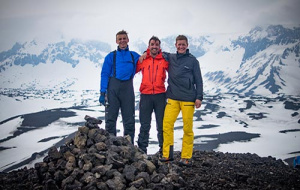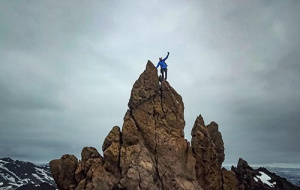Return to Vatnajökull report

The expedition team on the Northern edge of the Vatnajökull icecap. The cairn here was built in 1932 by a Cambridge expedition, and contained artefacts from their visit, including a handwritten note.
In April, a team composed of three Univ alumni, John-Henry Charles (2012, Earth Sciences), Glen Gowers (2012, Biochemistry), and Oliver Vince (2012, Engineering) – supported in-country by DPhil student Sam Cornish (2016, DPhil Earth Sciences) – set out to see whether microbes could be identified and studied in real time as part of an ongoing icecap expedition. Oliver wrote this report about their Icelandic experience.
You would be forgiven for thinking that nothing lives at the polar extremes of our planet. Vast, frozen wastes span for hundreds of miles in every direction, with the white of the snow blending seamlessly into the white of the sky. By and large, travelling across an icesheet, you’re unlikely to come across much animal life.
But this wasteland is teaming with microbial life invisible to the naked eye. As our climate continues to change we are deepening our understanding of the role that these microbes play. Understanding how they respond to climate change is fundamental to a holistic understanding of our climate. One example of the interaction that these microbes have on the polar climate is microalgae that thrive as the ice surface darken the surface of the ice to such an extent that it is visible from space. This increases the temperature of the ice surface and accelerates melting.

A brief window of ‘good’ weather on the Vatnajökull icecap for the 2019 team
Our mission was to try and become the first team to conduct microbial DNA sequencing in a polar environment, completely off-grid, with no guides or vehicles for support. Demonstrating this would create a blueprint for future scientists to probe microbial communities in ever more remote locations, expanding our knowledge of these microbes to further extremes.
The icecap chosen for this test was the Vatnajökull, Europe’s largest. At nearly 8000km2, the Vatnajökull is an immense icy plateau spanning between the two highest points in Iceland. Receiving the harshest weather blowing in from the Atlantic Ocean, the icecap is renowned for its high winds and heavy snowfall.

Mountaineering in the Kverkfjöll mountain range
Our route, chosen to follow the footsteps of the 1932 Cambridge expedition, also yielded some interesting historical findings. Using the descriptions in their diary, we were able to find the 1932 basecamp, from which they conducted biological, glaciological and geological surveys. Amongst other discoveries, we found a handwritten note that had lain buried for 87 years. We were also able to retake several of their photographs and re-survey their basecamp. We are pleased to report that we were able to successfully sequence the microbes present on the Northern edge of the Vatnajökull icecap using solar power alone. This required miniaturising an entire laboratory (into an 18 litre volume) and transporting delicate equipment (some of which couldn’t freeze!) across 100km of icecap using human power alone. Interestingly, 50% of the microbes we sequenced have not yet been characterised!
This work has established a blueprint for expeditions that wish to conduct polar microbial research in the future. This, and our findings are explained in much more detail on our website and have been verified by leading academics in the field.
Published: 13 August 2019
Explore Univ on social media
